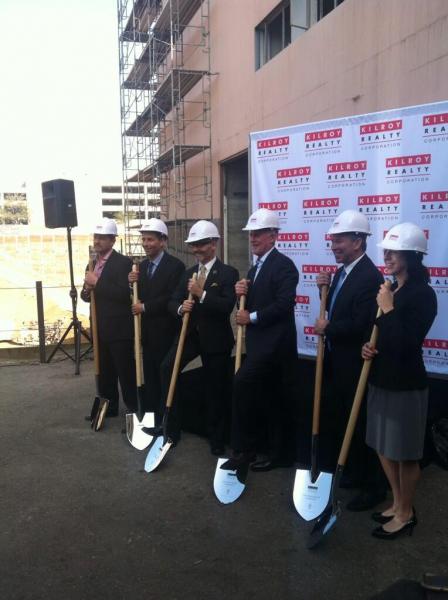Ground Broken On Long-Awaited Columbia Square Project

“This is so significant,” says Councilman Mitch O’Farrell, who represents Hollywood as part of District 13. “I think it represents the fact that Hollywood has returned. This is the template for new creative development in Hollywood that helps the industry and helps local residents because it’s an urban lifestyle center and it helps the local economy."
There has been no shortage of upheaval surrounding the project since it first came to light in 2008. It was originally intended to be an $850 million development centered on a 40-story skyscraper, but the proposal swiftly drew significant community backlash. An amended design, this time featuring a 28-story tower and a seven-story hotel, was unanimously approved by the Council in July 2010 only to never get off the ground when the property’s owner, iStar Financial, suffered heavy financial losses due to economic downturn. Kilroy Realty, the property’s current developer, purchased the site from iStar in October 2012 for $65 million and downsized it further, the first piece of what Kilroy senior vice president David Simon says will be an $800 million total financial investment by the company in Hollywood.
The project has drawn praise for its preservation of the site’s history, highlighted by the renovation of the original CBS Studio A as a production facility for rent. The building opened in 1938 as what was then the country’s most technologically advanced broadcast site and was home to radio programs hosted by the likes of Orson Welles, Jack Benny and comedy duo George Burns and Gracie Allen. Memorabilia and exhibits from Studios B and C will also be on display as an exhibit in the building’s new lobby.
Perhaps more importantly, it will be a boon to job growth. The development has created roughly First Source 1,300 construction jobs and is expected to generate 3,000 more permanent jobs upon completion.
"It is one of the largest job creators in Hollywood in a long time," says O'Farrell. “We’re a growing city... [and] we need to grow in the right ways. A city cannot grow or sustain itself if your economic development piece is lacking, and with that, jobs. Los Angeles has had a jobless recovery, so we have to figure that out.”
Detractors of the plan question whether its public housing benefits, which include giving first right of purchase for condominium units at full market price to employees who work at the site plus a one-time donation by Kilroy in the range of $2.25-$3 million for affordable housing, go far enough, a charge O’Farrell disputes by noting that the donation was negotiated into the deal and not mandated by law.
There is also the matter of traffic, and whether the new development will exacerbate the already-clogged streets near the site’s intersection of Sunset Blvd. and Gower St. Part of the agreement stipulates that Kilroy and the City Council collaborate on a neighborhood traffic management plan and while its parameters are already being discussed, O’Farrell allows that the plan itself will not be implemented until after the construction phase is complete. Included among the provisions are a four-and-a-half story underground parking garage and a ride sharing program, though Simon believes that Columbia Square’s location will help mitigate further automobile traffic as Angelenos continue to rely more on public transportation, walking and bike riding.
“One of the things we really liked is the Red Line is one block away and unlike most things in L.A., this particular Red Line has high use,” he says. “So all of those things, coupled with the bicycle racks and showers and locker rooms, we’re really doing our part in trying to mitigate any of those kinds of issues.”
Columbia Square is scheduled to open in stages, beginning with the restored studio in late 2015. The project is expected to be completed in 2016.



